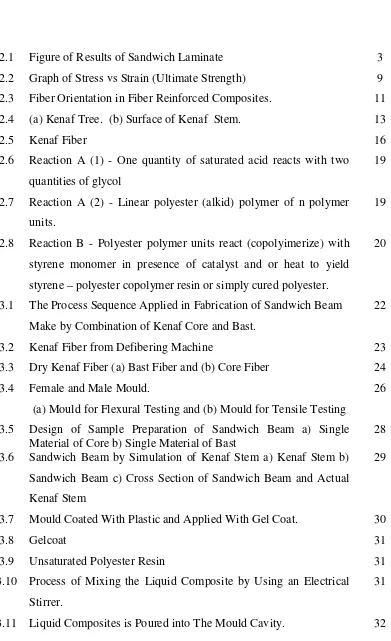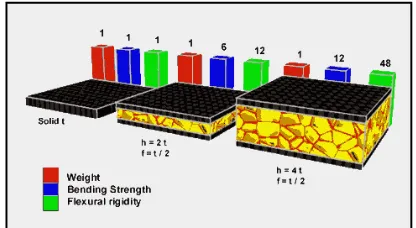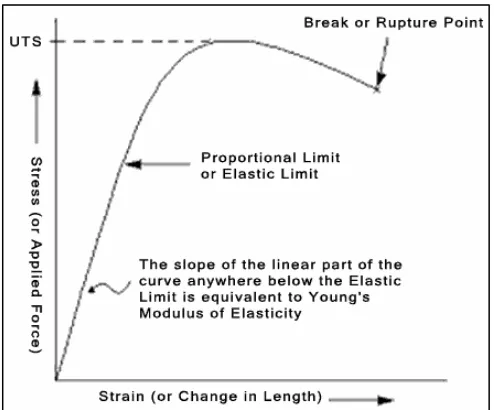UNIVERSITI TEKNIKAL MALAYSIA MELAKA
DESIGN AND ANALYSIS OF SANDWICH BEAM MAKE
BY COMBINATION OF KENAF CORE AND BAST
Thesis submitted in accordance with the requirements of the University Technical Malaysia Melaka (UTeM) for the Degree of Bachelor of Engineering (Honours) Manufacturing (Material Engineering)
By
NOOR ALIAH BINTI NORDIN
Faculty of Manufacturing Engineering
ii
DECLARATION
I hereby declare that this report entitled “DESIGN AND ANALYSIS OF SANDWICH BEAM MADE BY COMBINATION OF KENAF CORE AND
BAST” is the result of my own research except as cited in the references.
Signature :
Author’s Name : Noor Aliah Bt Nordin
iii
APPROVAL
This report is submitted to the Faculty of Manufacturing Engineering of UTeM as a partial fulfillment of the requirements for the degree of Bachelor of Manufacturing Engineering (Material Engineering). The members of the supervisory committee are
as follow:
iv
ABSTRACT
v
ABSTRAK
vi
ACKNOWLEDGEMENTS
I would like to convey my sincere appreciation and my utmost gratitude to my
project supervisor, Mr Mohamad Haidir bin Maslan for his support, guidance and
advise throughout the process of completing my PSM 1. Also my appreciation to Mr.
Edeerozey Abdul Manaf for helping me in order to visit Forest Research Institute
Malaysia (FRIM) to get the information about kenaf. Thankful for Mr. Mohd. Jani
Saad from FRIM which supplied raw material, kenaf fiber. My deepest appreciation
to my family who have given me non-stop inspiration and also supported me
financially. I would also like to express my sincere appreciation to my friends for
vii
List of Abbreviations, Symbols, Specialized Nomenclature………….……... x
ix
3.6.1.2 Flexural Tests………. 36
4. RESULTS 37 4.1 Number of Specimens……… 37
4.2 Data Analysis………. 39
4.2.1 Mechanical Test………. 39
4.2.1.1 Tensile Test……….. 39
4.2.1.2 Flexural Test………. 40
4.2.2.2 41
5. DISCUSSION 48 5.1 Tensile Properties………. 48
5.2 Flexural Properties……… 51
6. CONCLUSION AND RECOMMENDATION FOR FURTHER WORK 56 6.1 Conclusion……… 56
6.2 Recommendation for Further Work………. 57
REFERENCES 58 APPENDICES ……...……….….... A Table of Weight of Material for Fabrication Specimen ..……….... 60
B Table of the Service factor and Composite Service Factor ……….. 61
x
LIST OF FIGURES
2.1 Figure of Results of Sandwich Laminate 3 2.2 Graph of Stress vs Strain (Ultimate Strength) 9 2.3 Fiber Orientation in Fiber Reinforced Composites. 11 2.4 (a) Kenaf Tree. (b) Surface of Kenaf Stem. 13 styrene – polyester copolymer resin or simply cured polyester.
20
3.1 The Process Sequence Applied in Fabrication of Sandwich Beam Make by Combination of Kenaf Core and Bast.
22
3.2 Kenaf Fiber from Defibering Machine 23 3.3 Dry Kenaf Fiber (a) Bast Fiber and (b) Core Fiber 24 3.4 Female and Male Mould.
(a) Mould for Flexural Testing and (b) Mould for Tensile Testing
26
3.5 Design of Sample Preparation of Sandwich Beam a) Single Material of Core b) Single Material of Bast
28
3.6 Sandwich Beam by Simulation of Kenaf Stem a) Kenaf Stem b) Sandwich Beam c) Cross Section of Sandwich Beam and Actual Kenaf Stem
29
3.7 Mould Coated With Plastic and Applied With Gel Coat. 30
3.8 Gelcoat 31
3.9 Unsaturated Polyester Resin 31 3.10 Process of Mixing the Liquid Composite by Using an Electrical
Stirrer.
31
xi
3.12
Mechanical Cold Press Machine 150 Ton for Impact the
Specimen During Curing Process.
32
3.13 Composite Panel After Removed From Mould. (a) 20% Kenaf Bast, (b) 20% Kenaf Core and (c) Sandwich Beam
33
3.14 The Cutting Specimen into Desired Size for Each Testing 33
3.15 The Instron Model 1122 Machine 34
4.1 Specimen had been prepared a) The Samples Testing for Kenaf Bast (b) The Samples Testing for Kenaf Core (c) The Sample Testing for Sandwich Beam from Calculation (d) The Samples Testing for Random Sandwich Beam
38
4.2 Schematic Diagram for Sandwich Beam (16mm) 41 4.3 Schematic Diagram for 3 Point Bending Testing 43 4.4 Schematic Diagram for Sandwich Beam (6mm) 44 4.5 Schematic Diagram for 3 Point Bending Testing 45 4.6 Figure of the Stress of the specimen (6mm) 46 4.7 Figure of the Stress of the specimen (16mm) 47 5.1 Graph of Tensile Strength vs Strain for Bast Fiber Reinforced
Composite
49
5.2 The Specimen of the Kenaf Bast Fiber after Testing 50 5.3 The Specimen of the Kenaf Core Fiber after Testing 50 5.4 Graph for Tensile Stress vs Strain for Core Reinforced Composite 50 5.5 Graph of the Tensile Strength vs Kenaf Fiber with the Same
Volume (20%)
51
xii
LIST OF TABLES
2.1 The Comparison of Chemical Composition 14 2.2 Table of the characteristics of liquid resins for non electrical
applications.
20
4.1 The Number of Specimens Had Been Prepared 37
4.2 Data of Tensile Testing 39
xiii
FRIM Forest Research Institute of Malaysia MEKP Methyl Ethyl Ketone Peroxide
PMCs Polymer–Matrix Composites MMC Metal Matrix Composites (MMC)
CMC Ceramic Matrix Composites (CMC) PMC Polymer Matrix Composites (PMC
1
CHAPTER 1
INTRODUCTION
1.1 Background
Many fibers are produced and the natural fiber is commercialized. In past few years, the demand that use of natural fiber as reinforcement is increased. The increasing is because of the economy factor and the environments to change the fiber synthetic as reinforcement. The advantages of natural fiber are because of the low cost, easy to find, lightweight and high strength to weight ratio. Besides, the uses of natural fiber in manufacturing industry are increasing. This is because of the insufficient sources and also followed by increasing of the construction materials based on the mineral sources such as aluminum, steeland also the forest trees.
2
1.2 Problem statement
In the world of composite manufacturing the manufacturer always find the best materials for sandwich beam that have the outstanding properties. This study will use two types of materials kenaf as a reinforcement and polyester as a matrix for making sandwich beam which followed by mechanical testing in order to investigate the suitable thickness base on actual kenaf stem, layers and the compabality of the kenaf and polyester skin.
1.3 Objectives of the research
a) To investigate the mechanical properties of the sandwich beam from the combination of polyester and kenaf stem for possible use in composite structure.
b) To investigate the suitable thickness of sandwich beam based on the simulation of kenaf stem.
c) To find the best parameter for this composite structure.
1.4 Scope of the thesis
3
CHAPTER 2
LITERATURE REVIEW
2.1 Introduction
The basic principle of a sandwich was discovered in 1820 by a French inventor named Duleau. The sandwich laminate is an extremely efficient structural design. The structural of sandwiches are a special form of laminated composite in which thin, strong, stiff, hard and there also combined with thick, relatively soft, light and weaker cores to provide a lightweight composite stronger and stiffer in most respects. Basically, a sandwich construction are includes the two laminates which is outer and inner. The core material is made as a spacer and adhesive for bonding of laminates. Besides, common materials for the laminates are composite, metal or wood. The core can be made of paper, honeycombs made of impregnated aramid-paper or thermoplastics and all kind of foams. Even though the using of sandwich laminates for many companies and for variety of products are popular but it is still hard to find the reliable design information. The example of sandwich laminate is as shown in Figure 2.1.
4
2.2 Composite
Composites are combinations of two materials in which one of the materials, called the reinforcing phase and another one is matrix. The reinforcing phase is in the form of fibers, sheets or particles. The matrix is the monolithic material into which the reinforcement is embedded and is completely continuous. This means that there is a path through the matrix to any point in the material, unlike two materials sandwiched together. The reinforcing material and the matrix material can be metal, ceramic, or polymer. Typically, reinforcing materials are strong with low densities while the matrix is usually a ductile or tough material. If the composite is designed and fabricated correctly, it combines the strength of the reinforcement with the toughness of the matrix to achieve a combination of desirable properties not available in any single conventional material. The strength of the resin or fiber composite depends primarily on the amount, arrangement and type of fiber reinforcement in the resin. Typically, the higher the reinforcement content provides the greater the strength.
The combination of two or more material with the different phases is to attain more stable element and properties. It is because the properties of each component can contribute in combination. (Richardson,1987). There are three main situations that mean of the materials are composite:
a) Consists of two or more material which is the physically are different and can be separate it mechanically.
b) The properties of composite produced are excellent and extremely good in certain case compared to individual component.
c) By spreading method, composite can be made by combining the material to attain the optimum properties.
5
matrix is followed by brittleness. However, the combination of fiber reinforcement and matrix can made more strong material. (Rozman et al.,1998a; Rozman et al.,1998b; Abdul Khalil et al.,2001 dan Abdul khalil et al.,2002a)
2.2.1 Matrix
The matrix is the monolithic material into which the reinforcement is embedded, and is completely continuous. This means that there is a path through the matrix to any point in the material, unlike two materials sandwiched together. In structural applications, the matrix is usually a lighter metal such as aluminum, magnesium, or titanium, and provides a compliant support for the reinforcement. The common matrix used for fiber reinforced plastic or thermoset composite process such as Epoxy, Unsaturated Polyester (UP), Vinylester, Urea Formaldehyde, Urethanes, Melamine, Phenolics, etc.The most common man-made composites can be divided into three main groups:
a) Polymer Matrix Composites (PMC) or Fiber Reinforced Polymers (FRP)
PMC or FRP are the most commonly used composites. These materials use a polymer-based resin as the matrix, and a variety of fibers such as glass, carbon and aramid as the reinforcement. Natural polymer, thermoplastic polymer and thermosets polymer are in family of Polymer Matrix Composites.
b) Metal Matrix Composites (MMC)
MMC composites are increasingly found in the automotive industry. They use a metal such as aluminium as the matrix, and reinforce it with fibers such as silicon carbide.
c) Ceramic Matrix Composites (CMC)
6
2.2.2 Reinforcement
The reinforcement material is embedded into the matrix. The reinforcement does not always serve a purely structural task but is also used to change physical properties such as wear resistance, friction coefficient, or thermal conductivity. The reinforcement can be either continuous or discontinuous. Discontinuous MMCs can be isotropic and can be worked with standard metalworking techniques such as extrusion, forging or rolling.
Continuous reinforcement uses monofilament wires or fibers such as carbon fiber or silicon carbide. Because the fibers are embedded into the matrix in a certain direction, the result is an anisotropic structure in which the alignment of the material affects its strength. One of the first MMCs used boron filament as reinforcement. Discontinuous reinforcement uses whiskers, short fibers, or particles. The most common reinforcing materials in this category are alumina and silicon carbide. The advantages of natural fibers are:-
a) Low specific weight which results in a higher specific strength and stiffness than glass. This is a benefit especially in parts designed for bending stiffness.
b) It is a renewable resource, the production requires little energy, CO2 is used
while oxygen is given back to the environment.
c) Producible with low investment at low cost which makes the material an interesting product for low-wage countries.
d) Friendly processing, no wear of tooling, no skin irritation
e) Thermal recycling is possible where glass causes problems in combustion furnaces.
7 The disadvantages of natural fibers are
1) Lower strength properties particularly its impact strength
2) Variable quality depending on unpredictable influences such as weather 3) Moisture absorption which causes swelling of the fibers
4) Restricted maximum processing temperature.
5) Lower durability and fiber treatments can improve this considerably 6) Poor fire resistance
7) Price can fluctuate by harvest results or agricultural politics.
2.2.3 Characteristics of Composite
Composites are anisotropic materials which their strength is different in different direction. Their stress-strain curves are linearly elastic to the point of failure by rupture. The polymeric resin in a composite material, which consists of viscous fluid and elastic solids, responds viscoelastically to applied loads. Although the viscoelastic material will creep and relax under a sustained load, it can be designed to perform satisfactorily. It is also highly desirable qualities which are high resistance to elevated temperature, abrasion, corrosion, and chemical attack.
2.2.3.1 Properties of Composites
The basic principle behind fiber-reinforced polymers is to combine fibers that bear mechanical loads with polymer matrices that distribute these loads over the fibers. The matrix also protects the fibers. Because composites are a mixture of resin and reinforcing fibers, the properties of the end product are a combination of the properties of the resin on its own and the fibers on their own. Generally, composites have many excellent structural qualities include high strength, material toughness, fatigue endurance and light weight.
8
structure without adding substantial weight. The other advantages of composite structural are includes ease of manufacturing, fabrication, handling and erection. Sandwich structures have in several applications to have fatigue strength, acoustical insulation and additional thermal insulation. The absorption of mechanical energy can in some deformation modes is multiplied compared with monocoque structures due to an imposed shorter mode of buckling waves. The use of cellular cores obviates the need to provide additional thermal insulation, ensuring low structural weight, since most cellular cores have a low thermal conductivity.
2.2.3.2 Loading Conditions
Composites by made up of resin and reinforcing fibers can tests with kinds of loads during their lifetime. There are four main direct loads that any material in a structure has to withstand which are tension, compression, shear andflexure.
2.2.3.3 Tensile
9
Figure 2.2: Graph of stress vs strain (Ultimate Strength)
This test method covers the determination of the tensile properties of thermosetting reinforced plastic using test specimens of uniform nominal width when tested under defined conditions of pretreatment, temperature, humidity and testing machine speed. This test method can be used for testing materials of any thickness up to 14mm (0.55 in). (ASTM D5083-96, Standard Test Method for Tensile Properties of Reinforced thermosetting Plastics Using Straight-Sided Specimens)In Hooke's Law, for most tensile testing of materials will notice that in the initial portion of the test, the relationship between the applied force or load and the elongation the specimen exhibits is linear. Define of Hooke's Law where the ratio of stress to strain is a constant, E = / . The formula for the tensile stress is:
= F A
Where,
= tensile stress
F= tensile force over the rod
10
2.2.3.4 Shear
When a composite is experiencing a shear load, this load is trying to slight adjacent layers of fibers over each other. For a composite to withstand shear loads, the resin must have good mechanical properties as well as high adhesion to the reinforcement fiber. To indicate this property in a multilayer composite (laminate), a value for the Interlaminar Shear Strength (ILSS) is often used.
2.2.3.5 Flexural
Flexural testing is also a mechanical testing to measures the behaviour of materials subjected to simple bending loads. This testing is commonly used on brittle materials such as composite, ceramics, stone, masonry and glasses. It can also be used to examine the behavior of materials which are intended to bend during their useful life such as wire insulation and other elastomeric products. Flexural testing involves the bending of a material, rather than pushing or pulling to determine how much the material can bend before it breaks as well as the relationship between bending stress and deflection.


